— This week’s Monday Roundup is sponsored by River City Bicycles.
Welcome to the week. Here are the most noteworthy items we came across in the past seven days…
Domin-knows: The subtext of this news about Dominoes Pizza investing heavily in e-bikes for pizza delivery is that bicycles are faster and more reliable in urban traffic than cars.
Working class ‘cross: Sellwood-based Team S & M is gaining national attention in the cyclocross world for its grassroots elite team and the mechanic and manager behind it all.
Curb management: An experimental system in D.C. allows people to reserve space at the curb (a.k.a. the bike lane) for loading/unloading.
Car bans trending: Seems like every week there are articles about why it makes sense to ban and/or severely limit driving access to urban cores. It’s simple: Cars take up too much space and are easily transformed into killing machines. What are we waiting for?
Advertisement
Freeway fighters rejoice: The federal transportation bill proposal contains a $120 million (over five years) grant program that aims to help community groups tear down interstate highways.
A bit of history: If you love the history of human-powered mobility as much as we do, you owe it to yourself to read this Roots of Progress post about why it took so long for the bicycle to be invented.
Bike subscription: Swapfiets is a service that offers a monthly subscription to a bicycle. Sort of like bike-share without the sharing.
The problem with two-way bike lanes: Already controversial, bi-directional bike lanes (which are very popular with PBOT these days) got more bad press this week when a new study found that they cause more crashes than other types of cycling infrastructure.
Designing for people: Strong Towns has coined the new term of “fantasy pedestrian” to describe the mythical human that follows all laws and never their own desires.
— Jonathan Maus: (503) 706-8804, @jonathan_maus on Twitter and jonathan@bikeportland.org
Never miss a story. Sign-up for the daily BP Headlines email.
BikePortland needs your support.

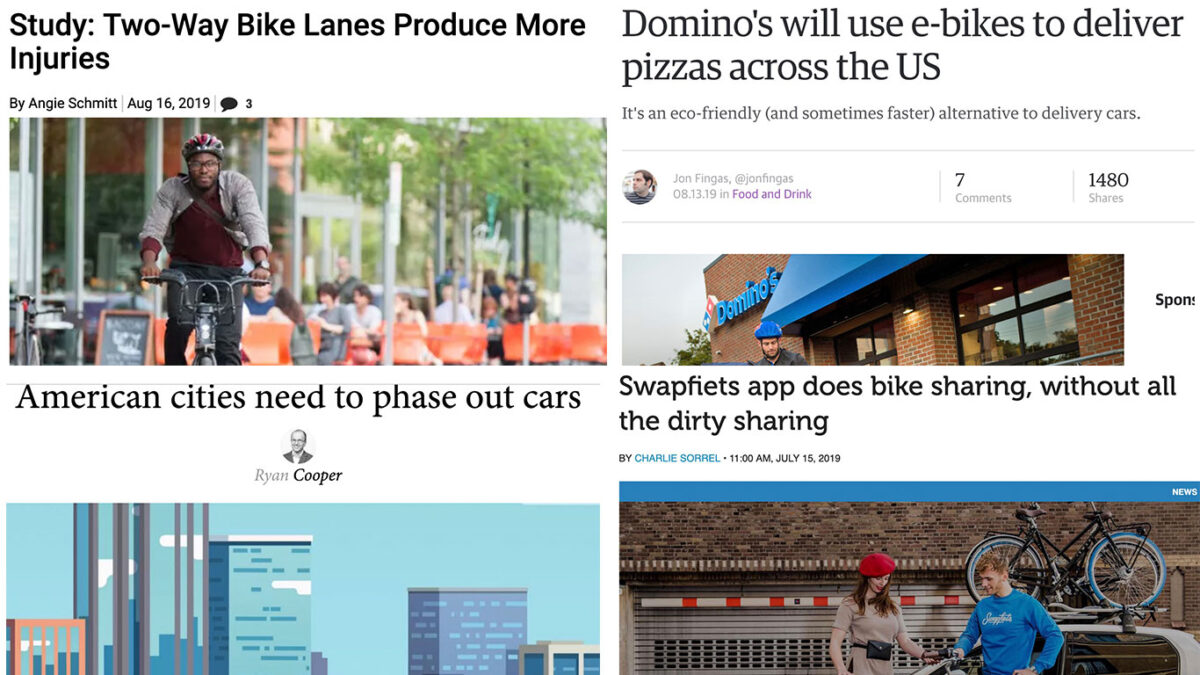
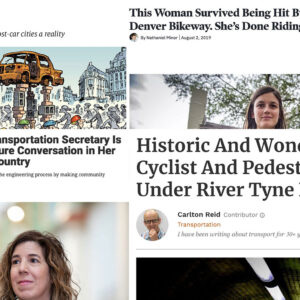
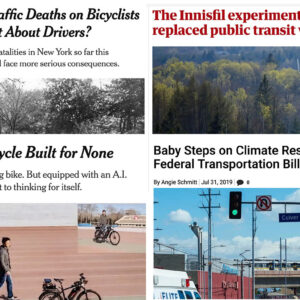
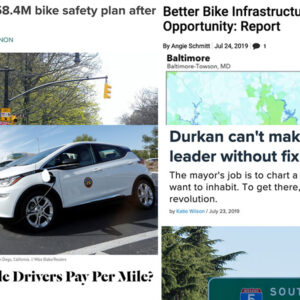
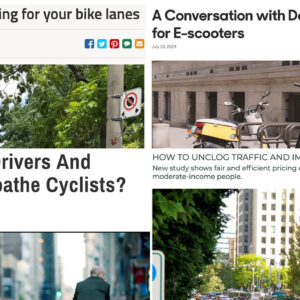
Thanks for reading.
BikePortland has served this community with independent community journalism since 2005. We rely on subscriptions from readers like you to survive. Your financial support is vital in keeping this valuable resource alive and well.
Please subscribe today to strengthen and expand our work.
The problem with two-way bike lanes: I hate them because there’s always a difficult connection at the ends when you need to cross over to the correct direction when the bi-directional lane ends or starts.
$120 M for freeway removal is such a small number. I’d guess you can’t remove many lane-miles for that figure. Seattle’s Alaskan Way viaduct removal is probably going to be north of $300M https://seattle.curbed.com/2017/8/3/16092162/alaskan-way-viaduct-demolition https://www.wsdot.wa.gov/Projects/Viaduct/Budget
Eh? That Curbed link quotes the demolition (of the viaduct AND a nearby tunnel) at 93.7 M. The 300 M figure comes from building the Alaskan Way tunnel as well.
You’re correct on the viaduct demo number, but the $300M figure includes the new Alaskan Way *surface* roadway, not the tunnel. The tunnel project itself was $2.1 billion.
Uh, total project cost there is about *eight times* $300M.
Must they be removed? I can think of other uses.
https://tinyurl.com/y4phddrm
Regardless of how fun it might be to ride bikes on, the Alaskan Way Viaduct in Seattle is being taken down because it is a structurally unsound elevated roadway, and removing it in a controlled way is the preferred alternative to it falling down on people in an earthquake.
Eugene got one of those “destroy the poor neighborhood by putting a freeway through it” things back in the ’60’s/’70’s (I-105). Over the past decade, including a project going on right now, ODOnT has spent many tens of millions of dollars widening it and shoring it up. This all strikes me as a waste that just encourages more short trips by car (with all the damage that brings).
Every time I look at the I-105 bridge over the Willamette, I envision this thing converted to a thriving car-free mixed-use development with people hanging out at the railings enjoying a sunset over the river on a summer’s eve. Sadly, it’s more likely to end up looking like the bridge in the final passage of “Earth Abides”.
Check out Dongho Chang’s Twitter. Once a year he posts ridership and crash stats on downtown PBLs. I think the two ways also have reduce crashes for all modes. (Putting it out there as an interesting counter point). Disclaimer: I am a big Dongho fan
2-way bike lanes: I really dislike them so I love this article before even reading it! I dislike them for the difficult connections to get on/off them, and dangerous conditions they create at intersections.
And driveways, don’t forget the conflict of 2-way cyclestracks at driveways. I’ve pretty much sworn them off and will go out of my way to avoid them. I’d rather ride on a parallel arterial with no bike lane than use a 2-way cycletrack.
Last year my wife decided to give another try to one of them. She “only” had three near collisions with motorists who couldn’t be bothered to look and see a bike. (Since she saw the situation setting up and she’s a competent ride, they weren’t quite near-collisions, more like “take evasive action to avoid a close call” events.)
Does anyone run a “Zipcar for cargo bikes” type service? I would be interested in a service that gives me shared access to a cargo bike instead of buying/storing my own. That sort of service would be much more appealing to me for specialized/infrequent needs than renting an everyday ride like Swapfiets.
Looks like Clever Cycles rents their ebikes and cargo bikes (see link). That’s less convenient the further you get from Hawthorne and 16th though. Maybe other bike shops could be convinced to join them?
I would think Clever Cycles’ service is a lot more like Hertz than Zipcar.
Interesting that Domino’s Pizza (not Dominoes, BTW) would invest in any kind of transportation. I thought pizza-delivery chains generally usually just paid a wage, relying on drivers to supply their own vehicles?
I have long argued that Domino’s is not a pizza company. They are a food-delivery technology company. Delivery via e-bikes is totally within their wheelhouse and does not surprise me at all.
Re: how long it took to develop the bicycle as we know it …
I’ve been surprised by this as well. The bicycle is a vastly simpler machine than the automobile, and arguably should have been invented far earlier than it was. I understand that (as explained in the article) cultural factors probably explain why it wasn’t invented until the 19th century, but I don’t think it fully explains why it took so long within the 19th century. I’m not buying that development of materials science and manufacturing are what held it back. Nor do I accept that the VERY late development of the pneumatic tire was essential to the bicycle’s invention, even if it was essential to for its ultimate explosion in popularity.
We had the working velocipede in 1817. But no one would figure out to hook up pedals and cranks to it for literally another half-century. The first true bicycles took off in 1867, with pedals driving the front wheels. It would be years yet before anyone figured out to drive the rear wheels, along with the mechanical advantage and higher speeds that arrangement makes possible.
It’s not like people weren’t motivated to do it. According to David Herlihy’s Bicycle, after the initial draisine boom there was quite a lot of interest among tinkerers, tradesmen and scholars in developing a working propulsion system, and experiments continued from the 1820s through the 1850s, in France, England, Scotland and America. The focus seemed to be more on treadle-type arrangements, which had efficiency and weight problems but did provide mechanical advantage to allow for higher speeds.
How did the magic light bulb – putting pedals on a velocipede – not go off? Seems to me we could have had something resembling the safety bicycle long before we did. The technologies existed. There were plenty of would-be inventors working on velocipedes in their shops and backyards. We got very close: Herlihy’s book even shows an 1850 picture of a small child on a lever-and-pedal-driven tricycle much like those of today. But it didn’t make it to the adult velocipede. A pre-1950 machine would have had to make do with solid rubber tires, of course, but it still could have been fairly usable. Too bad no one caught the spark. (And who knows, if the bicycle had been around earlier, someone else might have been motivated to beat Dunlop to the punch on the pneumatic tire).
Why this matters is this: the bicycle effectively predated the automobile by only a very few years. Even with its ultimate nemesis looming in the near distance, the bicycle’s popularity prompted the improvement of roads and streets across the nation. Imagine if this happened 30 or 50 years earlier: before the automobile came along, bicycles would have been clearly established as a viable form of transportation, with road rules, design, markings and signage codified around the bicycle well in place, and accepted by the population. We would be living with a VERY different reality on our streets if history had gone just a little bit differently.
The obvious conclusion you get from reading curb management article is that in a near future world of increasing e-commerce deliveries, ride share . etc. the thing that is quickly becoming obsolete is the parking ( free storage) of private cars on the public curbside. Bringing this up makes the MOTROG’s ( motoring troglodytes) heads explode, but it is an inescapable conclusion.
>>> What are we waiting for? <<<
Perhaps a better system that provides point-to-point transportation, carries cargo, affords privacy and protection from the weather, is capable of traveling long distances, and is (in most cases) reasonably fast and not terribly expensive?
The only thing I see coming that will change will change the dominance of cars as primary transportation are self-driving cars, which, depending on how you look at it, will either be revolutionary or not much change at all.
Hello, Kitty,
IMO the best way to create that better system you defined in your comment is to end the public subsidy and encouragement of the existing (worse) system. Nothing stokes creativity and new paradigms like limiting something that is in high demand. And as you know, people don’t demand cars, they demand a cheap, efficient, fun, safe way to get around. Unfortunately government makes one vehicle compete better than any other at providing those things… so guess what? That’s what everyone does.
I have long argued for a carbon tax, which would have the effect of making driving more expensive. Probably significantly so. So I generally agree that driving needs to be more expensive.
I’m less sure I see the government’s hand in limiting non-automotive alternatives to the car that have those other attributes I mentioned that people seem to find so appealing.
If you’re unsure of the role government and law has played and continues to play in putting people into cars and keeping them from using other, better, means of transportation, I think you should read (and follow on Twitter) Gregory H. Shill. Here’s a starter link:
https://papers.ssrn.com/sol3/papers.cfm?abstract_id=3345366#.XPvtzLc5KJA.twitter
I read the abstract, and the article seems to focus on cost, not on other technologies that would serve the needs that card do.
“the article seems to focus on cost, not on other technologies that would serve the needs that card do”
You are asking too much. The things that the card do are a function of the fossil fuels that make them go. Instead of holding onto this anomalous standard we should allow that the fossil fuels were a one-time bonanza and agree to set our sights lower.
I know, not very American to concede that we are not in charge, can no longer lord it over other people, the planet.
The question I was addressing was “what are we waiting for” to start banning cars from cities, which I answered we are waiting to find another way to get the same benefits that cars give us.
Implicit in my comment was an acknowledgement that cars provide a lot of benefits to a lot of people. I think that acknowledging that fact is import for all transportation activists because that is the reason that cars are so entrenched. Not clever marketing, not government conspiracy, not any of the straw men we like to blame. People like cars because they are useful.
Trying to get rid of cars, even in the central city, without replicating their benefits will be a big lift. Asking people to wear hair shirts has never been an effective way to move forward.
“Implicit in my comment was an acknowledgement that cars provide a lot of benefits to a lot of people.”
And I am not disagreeing with the premise. Just not where you take that next.
“I think that acknowledging that fact is import for all transportation activists because that is the reason that cars are so entrenched. Not clever marketing, not government conspiracy, not any of the straw men we like to blame. People like cars because they are useful.”
I also like empty beaches, empty camp grounds, cheap real estate in the central city, swept bike lanes, well funded schools, free flowing freeways during rush hour, etc. But just becaue I like those things, find them useful, doesn’t mean I get to have all those things, or that they should be provided for me, indefinitely.
“Trying to get rid of cars, even in the central city, without replicating their benefits will be a big lift.”
Of course it will, but not because we need to persuade people, but because people are determined not to accept their demise, the sunsetting if that century-long binge.
“Asking people to wear hair shirts has never been an effective way to move forward.”
We are not asking. Cassandra wasn’t asking. She was foretelling.
The speed of climate change isn’t going to allow for slow pace of change to address it. Yes, there are global issues. But we also need to act locally. After living, and recently visiting a number of EU cities it is patently clear we need to end cars in Portland. Each city has done it similarly, and differently.
1. Car free zones in the inner city are a must. PBA needs to come along, there is enough data showing benefits to business. Parking on streets must end, replaced with lanes for other mobility. I-5 needs to be buried, and closed to downtown traffic. It is an “Interstate”. Last, Trucking for cargo has replaced shipping since the Port lost out. We should consider how to get this cargo off the highways.
2. E-commerce mobility with ebikes/bikes/scooters are evolving, and need work before they are a serious carbon saver. But where there was zero bike infrastructure they were thriving. Where there is an existing culture and infrastructure for biking, like Amsterdam, they would be abysmal and were few. But each city should find their way sooner than later.
3. Portland has been way to slow on both fronts. We need leadership, and a better city governance system to allow for change and less discussion.
>>> We need … a better city governance system to allow for change and less discussion. <<<
Presumably only if those doing the change without discussion are doing what you want them to do. What if they do something like expand I-5 through the Rose Quarter? Do you really want to give up your right to "discuss" what we do?
“slow pace of change”.
Portland’s transportation carbon emissions are still increasing:
https://twitter.com/PortlandBPS/status/1152270613110829056
And both vehicles and VMTs are steadily increasing with no end in sight.
People driving alone to work in PDX (Census ACS 5 year estimates):
2017: 193,289
2016: 187,929
2015: 183,153
2014: 178,506
Sure, but we’re going to cook the books by subsidizing a transition to e-cars. Those things come with ~2 tons CO2e/yr of embodied emissions front-loaded, none of which will show up as generated in Oregon. They will also cause us to need to triple, or more, the capacity of our grid, which will slow the rate at which we can transform it to carbon neutral.
And that, sadly, is what passes for environmental legislation out of our legislature.
It is darkly comical how Oregon democrats view electrification as some sort of panacea. EVs have been a nothing burger when it comes to emissions and are projected to be a nothing burger for decades (https://www.iea.org/gevo2018/).
The transformative changes described in the IPCC 5th AR and 1.5 C SR have been in public domain for years but most of these mitigation pathways are not even in the Overton window of Portland or Oregon politics.
Instead of exploring how we could create a more liveable future for young people, democrats are waiting for Elon Musk to save us.
PS: The problem with EVs is that their impact will take decades to accumulate and, at this point, we need rapid changes. We should have started electrifying in the 80s … but GM killed the electric car.
I’d say the biggest problem with E-cars is that a huge chunk of their lifetime emissions are front-loaded. Dumping 15-40 tons CO2e into the atmosphere this year for a vehicle that lasts about a decade would be terrible even if it ran on virtue signals.
I still can’t decide if the off-shoring of these manufacturing emissions is what makes them attractive to our politicians (evil intent) or if they simply don’t understand the issue (incompetence/ignorance). I hope it’s the latter, but I fear it’s both and when they get educated they’ll just hone their rationalizations.
One final thing never discussed about e-cars is that maintaining their infra (roads, charging stations, etc) will suck up public funds at the state and local level that could be better spent greening up our transportation sector, housing people, and generally meeting our needs in a climate emergency. Remember Salem losing its water supply last year to climate-change abetted toxic algae? Things like that are going to be much more common from here on out.
“I’d say the biggest problem with E-cars is that a huge chunk of their lifetime emissions are front-loaded. ”
Exactly. Mass conversion to EVs (unlikely) could increase our emissions over the short-term. This would be an unmitigated disaster.
And yet it will be exactly what happens.
Soren,
How about drive alone as a percent of total population?
How about compare percentages in Portland to other similar or larger cities?
Lies, damn lies and statistics…. – Mark Twain
soren’s statistics are perfectly valid. What I see from them is exactly what they say, and it’s not good–more people driving to work here, and more emissions. And his link is to the Bureau of Planning and Sustainability, which also expresses its concern. If you’re unhappy with someone using those statistics, then complain to BPS as well.
The fact that the population is increasing does mean the car trips and pollution per person MAY be less per person, but that’s not particularly reassuring. The fact that wasteful transportation methods and carbon emissions are affecting more people here than they used to isn’t helpful to me.
Those are census estimates which are just that estimates and will be potentially changed. Also it needs some context. Like the difference in the change in workers 16 years and over. With that context we’re actually removing people as a total percent of the working population from the drive to work alone pool.
Year__Work Force__Drive Alone__Wrk % Chng__Drv % Chng__Diff
2017__335,088____193,289_____3.00%________2.85%______-0.14%
2016__325,341____187,929_____2.66%________2.61%______-0.06%
2015__316,901____183,153_____2.89%________2.60%______-0.28%
2014__308,013____178,506
The “Cult of the Fantasy Pedestrian” makes several good points. Its photo of the path worn through the grass from people bypassing the poorly-designed path sums up a lot of what’s wrong with infrastructure design here.
On the opposite side of the coin, I heard a possibly apocryphal tale that when my alma mater was installing new paths, they just planted lawn everywhere, waited to see where paths were worn through the grass, then paved those paths.
That’s perfect. So often here, designers seem to start by figuring out how to STOP people from doing something (as in the article’s adding a barrier to stop people from crossing where it makes sense) instead of asking why people are doing something, and then creating a safe design that facilitates it. Then when people don’t use it, they (exactly per the article) say, “Well, we tried–not our fault if people don’t use it”. Of course it IS their fault because they gave people a poor design.
Of course, it works a little differently for cars. ODOT has determined that Cornelius Pass is a dangerous road because a number of speeding drivers have careened off the roadway, so they are spending $5.65 million to open up sight lines, realign some of the curves, widen the shoulders and put in stronger guard rails.
And of course, ODOT also continues to move ahead with the Rose Quarter project as if there are no objections, I commute through and work in the area, and regularly see survey crews, geotechnical drilling and other activities associated with the design and implementation process moving forward.
I think that has something to do with what I found to be the most resonant and piercing assertion of the entire article:
The first step in fixing a problem is admitting you have a problem. Well, and admitting what the real problem is. Hint: it isn’t a lack of fantasy pedestrians…